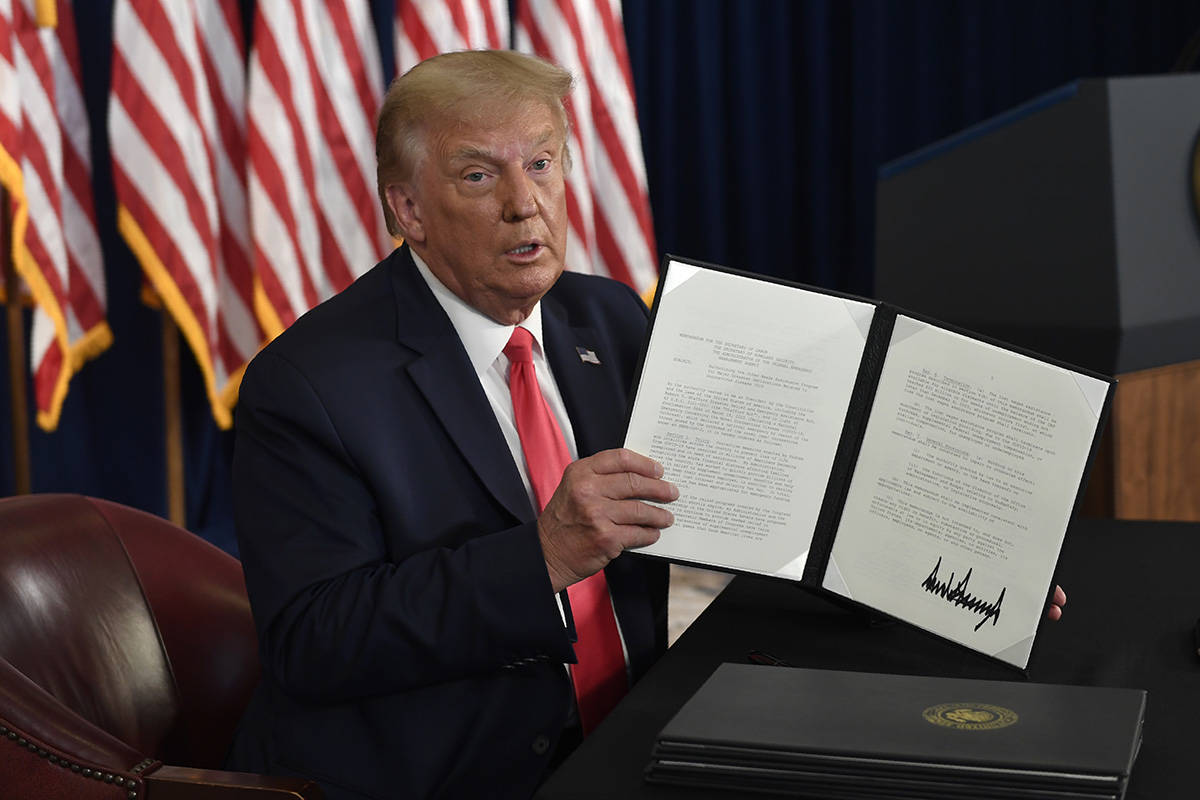FAQ: Executive order on unemployment, the $400 boost
If you’re one of the 30 million Americans in the unemployment system, you know this already: your $600-a-week Federal Pandemic Unemployment Compensation expired July 31.
That deadline pressured lawmakers to forge a second stimulus package with more aid for workers and struggling businesses. But talks among lawmakers, the Treasury Department and the White House broke down, no agreement on a stimulus bill emerged and now Congress is on a weeks-long recess until Sept. 8.
President Trump took action on his own, with four executive orders intended to fill the relief gap. One of them uses disaster relief funds to provide $400 a week in expanded unemployment benefits. “So, that’s generous,” he said, “but we want to take care of our people. Again, it wasn’t their fault.”
Swap the $600 check with a $400 one — simple, right? Not really. A close look at the president’s executive order on unemployment reveals that it’s a lot more complicated than that.
Here’s an FAQ on the president’s “lost wages assistance” program.
When will the $400 unemployment boost go into effect?
President Trump signed the executive order extending unemployment benefits on Aug. 8. The order itself says the benefits work retroactively, starting Aug. 1.
When the money will hit your bank account is an entirely different question.
Unemployment benefits experts estimate that it will take state agencies weeks — if not months — to begin making expanded payments to current unemployment recipients.
“States will have to set up a new way to add these payments to existing benefits. As we know, states have been straining under the weight of the surge of applications, said Rebecca Dixon, executive director at the National Employment Law Project, in a press release. “Setting up a new system entirely will be difficult, if not impossible.”
For reference, it took many states several weeks to implement FPUC, the initial $600 boost, which was a much simpler flat-rate provision. The CARES Act passed March 27. Then states awaited guidance from the Department of Labor. The DOL issued instructions on April 6. Florida, for example, didn’t start paying out FPUC until April 13 — 17 days after the law went into effect.
As of Aug. 12, both the DOL and FEMA released guidance to states. According to the process outlined by FEMA, which is bankrolling the new program, each individual state or territory needs to apply for the federal funds in the form of a grant and seek approval. FEMA will not be dispersing the unemployment payments itself. Payments will be handled by states when their new payment systems are in place.
Who’s eligible for the unemployment boost?
Anyone who is fully or partially unemployed due to the coronavirus pandemic and is receiving at least $100 a week in unemployment benefits is eligible.
The $100 of weekly benefits must come from one of the following unemployment programs:
— State Unemployment Insurance (UI)
— Pandemic Unemployment Assistance (PUA)
— Pandemic Emergency Unemployment Compensation (PEUC)
— Extended Benefits (EB)
— Self-Employment Assistance (SEA)
— Trade Readjustment Allowance (TRA)
— Short-Term Compensation (STC)
Those receiving less than $100 per week in unemployment payments won’t be able to collect the extra funds. This could include many PUA recipients, who are typically gig workers or independent contractors.
How much will I receive each week?
Based on the language of the executive order, states have leeway in how to implement the boosted payments. Depending on your state, you may receive $400 in addition to your current weekly payments. Or you may receive $400 total.
That’s because the order authorizes a $300-per-week bonus from the federal government. For the remaining $100, it’s asking states to pick up the tab. The order contains a provision that allows states to use current unemployment payments toward their $100 part of the bargain.
Depending on how your state implements the program, it’s possible you may see only a $300 federal bonus each week.
The order directs states to use $80 billion that remains in the Coronavirus Relief Fund (CRF) to cover their $100 portion. The problem is that these funds were issued to states months ago, and many have already earmarked the remaining money for other initiatives.
The White House has said that if states cannot afford their portion, the president can waive the requirement. How that process will play out is unclear.
Does the order apply to every state?
Yes, all 50 states, U.S. territories and Washington, D.C. are included in the program — technically.
However, the implementation of a full $400 boost is largely dependent on each state’s budget. Again, the federal government is guaranteeing only $300 per week. Many cash-strapped states have already aired concerns about being able to afford the remaining $100.
“We appreciate the White House’s proposals to provide additional solutions to address economic challenges; however, we are concerned about the significant administrative burdens and costs this latest action would place on the states,” governors Andrew Cuomo of New York and Asa Hutchinson of Arkansas wrote in response to the executive order.
In addition, state leaders of California, Delaware, Kentucky, Ohio, Mississippi, New Jersey and Pennsylvania expressed uncertainty about being able to afford the program.
If you live in a state that can’t afford it, you will receive a $300 boost to current benefits so long as you meet the other eligibility criteria.
How long will the boosted payments last?
The enhanced payments are authorized between Aug. 1 until Dec. 27. But the available funds are expected to deplete long before the cutoff date.
The $300 federal boost will be funded by a FEMA program, the Disaster Relief Fund. That fund contains roughly $44 billion — enough to provide $300 weekly checks for only about five weeks.
According to the DOL, the program will also end if a Congress passes a new law enhancing unemployment payments.
Can I get the $400 payments retroactively?
Yes. The lost wages program is in effect as of Aug. 1. As long as you are filling out your weekly unemployment claims (and are receiving at least $100 per week) you will be able to collect the enchanted payments for each eligible week while funding lasts.
Did you know: the $600 FPUC payments are also retroactive?
The clock is already ticking as states await DOL guidance and scramble to implement a new payment system. it’s possible that you will receive a lump sum that includes back pay when your state’s new system is finally in place.
What about the second stimulus bill?
A second stimulus bill isn’t off the table. Like the CARES Act, this next stimulus bill will be expansive, and is expected to include another stimulus check and several other relief measures for businesses and workers.
But a congressional agreement on extra unemployment benefits won’t happen until after Labor Day, when lawmakers return to the Capitol from their recess.
The president’s executive orders may have bought them some negotiating time. But with limited funding for tens of millions of jobless Americans, they may again be thrust into a race against the clock.
Adam Hardy is a staff writer at The Penny Hoarder. He covers the gig economy, entrepreneurship and unique ways to make money. Read his latest articles here, or say hi on Twitter @hardyjournalism.
This was originally published on The Penny Hoarder, a personal finance website that empowers millions of readers nationwide to make smart decisions with their money through actionable and inspirational advice, and resources about how to make, save and manage money.






















